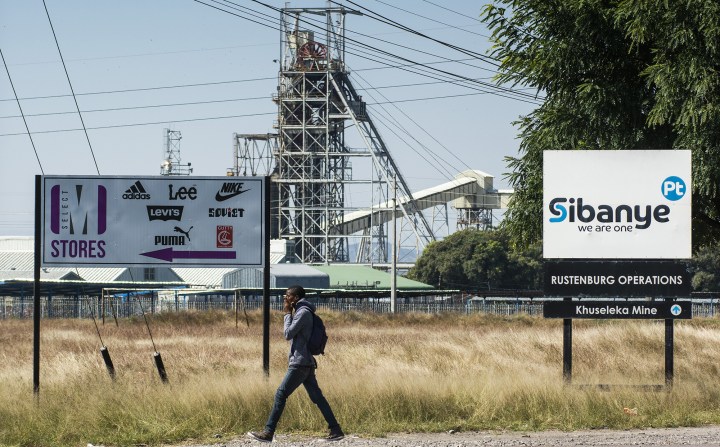LABOUR PAINS
Sibanye launches retrenchment talks, with more than 2,400 gold mine jobs on the line

The diversified metals producer has launched a section 189 process at its Beatrix gold mine No 4 shaft and its Kloof No 1 plant that could see more than 2,400 employees losing their jobs. The operations are making a loss and the affected employees will be the latest casualties in the long-term decline in South Africa’s once mammoth-sized gold industry.
Sibanye said in a statement mineral depletion and financial losses were the key drivers behind the proposed restructuring. It does not “cross-subsidise”, which means that its profit-making assets don’t prop up the loss-making ones, or at least not for a sustained period of time.
Such consultations do not always mean that lay-offs are set in stone. The life of the Beatrix 4 shaft was prolonged following a “section 189” — named for the section of the Labour Relations Act under which this process falls — following similar consultations in 2017.
The writing, this time around, seems to be on the tunnel wall and so the shaft will almost certainly be closed, but retrenched employees may find other work at Sibanye.
“It is anticipated that the consultation process will reduce the number of employees that may potentially be retrenched through the implementation of, among other things, possible retrenchment avoidance measures, including natural attrition, retirements, voluntary separation and the transfer of suitably skilled employees to vacant positions,” Sibanye said in a statement on Monday.
“The initiation of S 189 consultations follows numerous unsuccessful attempts to address productivity and other operational issues at the Beatrix 4 shaft and the depletion of Surface Rock Dump (SRD) mineral reserves to Kloof 1 plant.”
Such consultations last for 60 days, so these will be wrapped up by the end of the year.
“The SRD mineral reserves that are treated at Kloof 1 plant are nearly depleted, and the Kloof Main SRD will be completely mined out by December 2022. As a result, Kloof 1 plant will not be able to operate at full capacity, with its only remaining primary source of ore coming from Kloof 4 SRD. Cost reduction efforts have been ineffective in addressing the ongoing lack of profitability,” Sibanye said.
The company endured a strike lasting more than three months at its South African gold operations earlier this year but there is no explicit suggestion that this influenced the proposed retrenchments, which could affect up to 1,959 employees and 465 contractors. This includes possible lay-offs at Sibanye’s Gold Protection Services Limited and Sibanye Gold Academy Proprietary Limited.
In a letter to unions, the rationale behind the restructuring is spelt out in more detail.
“During the 19-month period from January 2021 to July 2022, Beatrix 4 Shaft reported cumulative losses of R 1.55-billion. These losses were experienced despite an average gold price of R931,916/kg in 2022, which was 17% higher than the R795,731/kg used to guide the planning process,” the letter says.
“The inability of the Beatrix 4 Shaft to deliver according to the operational plan with respect to production and operating costs, has impacted on operational profitability and sustainability. The Beatrix 3 Shaft at the Beatrix operation must subsidise the losses at the Beatrix 4 Shaft,” it says.
The letter also noted that the shaft lost 595kg to the strike earlier this year but went on to say that: “Despite these out-of-norm business interruptions, the profitability of Beatrix 4 Shaft remains uncertain under normal conditions.”
Eskom has reliably played a role here despite its unreliability. The letter says that since 2017, electricity costs have risen by 47% at Beatrix 4, adding to its unwelcome burden on its ability to generate a profit.
Geology is also eroding margins, for example, in the form of “smectite” which has been added to this journalist’s vocabulary.
Visit Daily Maverick’s home page for more news, analysis and investigations
“In addition to the cost pressures, Beatrix 4 Shaft struggled to meet its operational plan targets due to various operational interruptions, where underground workings have been adversely impacted by deteriorating underground conditions caused by a geological feature called smectite, a swelling type of clay which, when in contact with water, will expand and close off underground tunnels and accesses to the workings,” says the letter, which runs to 31 pages.
On top of that, grades have been in decline, which means the ratio of gold to tonnes of rock mined is falling. That has an obvious impact on the bottom line.
With an unemployment rate of more than 33% in a barely growing economy, any round of retrenchments in South Africa is simply a tragedy. Many of these workers will have dependants who rely on the steady income that was flowing to the household at a time when living costs have been going through the roof.
But this round of probable lay-offs is just the latest in the long and inevitable decline of South Africa’s once glittering gold industry. South Africa has been blessed with unimaginable mineral wealth, but what geology gives it gradually takes away. With industrial-scale mining, it is just at a far brisker pace than continental drift. Throw in the economic disincentives of a failing state, and the writing is indeed starkly etched on the tunnel wall.
Falling grades, ever-deepening depths, geological challenges such as “smectite” on top of soaring costs, mounting security concerns and government policy inertia have all combined to sink South Africa’s gold sector — which explains why new shafts are hardly being sunk.
In 1987, when South Africa was still the world’s largest bullion producer, its gold mines employed 554,000 people. By 2021, that number stood at 94,000, reflecting South Africa’s shrinkage to the world’s number 10 producer, according to World Gold Council and other data. This latest wave of lay-offs will bring that number closer to 90,000, and it is likely to fall below that in the near future.
Gold built Africa’s most industrialised economy while laying the foundations for apartheid and exclusion, and the glaring disparities of income and wealth that persist to this day. For better or worse, its historical legacy is also in decline. DM/BM















 Become an Insider
Become an Insider
The Unions are holding our miners to ransom and, in my opinion, are responsible for motivating the unrest at Marikane which ended in tragedy. Let’s hope this doesn’t happen this time around….job loss in these trying times will be used politically with major fallout for all South Africans and play right into the hands of the EFF.